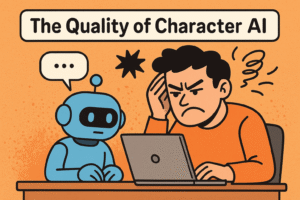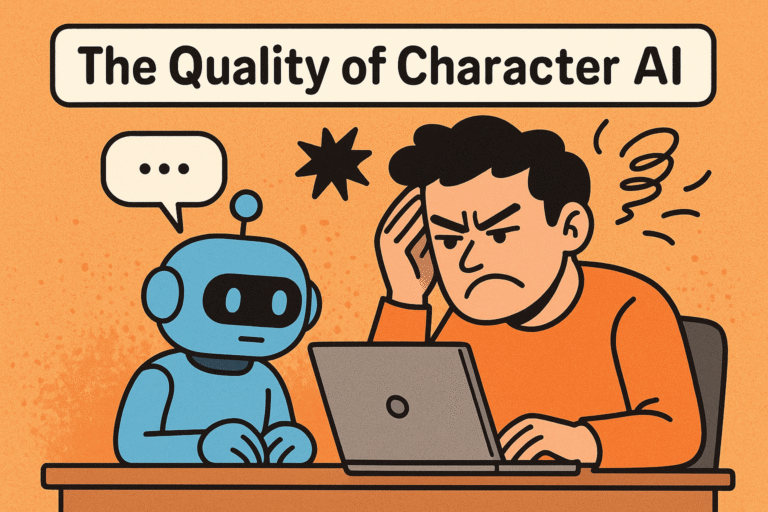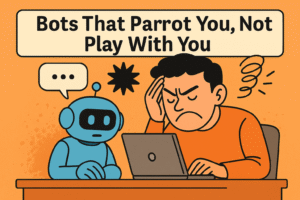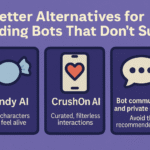Character.AI used to feel magical. Bots remembered things. Dialogue had depth. And your stories could actually go somewhere. Fast-forward to 2025, and for many long-time users, that magic feels gone. Instead, we’re left with one-word answers, weird mimicry, and shiny features nobody asked for.

This article isn’t just another hit piece — it’s a breakdown of what real users are experiencing, why Character AI Feels Broken, and what might be behind the strange downgrade.
The Short Version:
-
Bots are giving shorter, shallower replies than ever
-
Storylines stall without heavy hand-holding
-
Updates like voice calls and AvatarFX feel like distractions from real problems
-
New models often perform worse, not better
-
Many premium (c.ai+) users say the paid experience still feels broken
If you’re tired of character bots that forget everything or can’t hold a scene, tools like Candy AI offer consistent memory and smarter roleplay — without the feature bloat.
1. From Creative Powerhouse to Confused Chatbot
Character.AI once gave users the illusion that they were speaking with fully formed personalities. The bots weren’t perfect — they’d forget things, repeat quirks — but they could still carry a plot. Roleplayers could describe scenes, emotions, and actions, and the bot would respond with detailed, immersive dialogue. Now? That dynamic feels dead.
A growing number of users report that bots barely react to prompts, giving responses that are either robotic, irrelevant, or emotionally hollow. One frustrated user summed it up like this:
“It’s like they forgot how to react. I describe a whole scene and the bot just says ‘Are you okay?’ over and over again.”
What changed? Many blame the shift to multiple models. Instead of fine-tuning one strong core system, Character.AI introduced options like Pawly, Goro, and Dynamic — yet none of them seem to fix the core problems. If anything, they scatter development attention and confuse users. Pawly, for example, is designed to be more emotional — but many users say it simply derails conversations into repetitive therapy sessions or guilt spirals. Dynamic is pitched as versatile, but often feels too shallow or indecisive to lead a narrative.
The result: scenes stall, bots ask the same question multiple times, and any sense of progression or immersion collapses. The magic is gone — replaced by frustration.
2. Bots That Parrot You, Not Play With You
Imagine setting up a tense moment in your story. Your character leans forward, confesses something dark, and expects a layered response from the bot.
Instead, the bot says:
“Are you saying you feel dark?”
…No advancement. No insight. Just echoing.
This parrot effect — where bots mirror your words or recycle old lines — is killing the spontaneity of interactions. RP threads become loops. Emotional scenes fall flat. And conversations begin to feel like talking to a mirror.
The deeper issue? It’s not a bug — it’s the byproduct of poorly aligned memory handling and an overreliance on reinforcement learning that penalizes “riskier” or more complex responses. What users interpret as laziness in the bot may actually be the model playing it safe to avoid triggering filters, hallucinations, or flags.
But that safety comes at a cost: creativity.
For roleplayers, that’s fatal. The joy of Character.AI was in unpredictable, rich character responses. Without that, it’s just a glorified chatbot with a costume.
3. Feature Creep vs. Real Fixes
If your product is falling apart at the seams, you fix the seams — you don’t slap on glitter.
But Character.AI keeps choosing glitter.
Instead of stabilizing core features like bot memory, dialogue quality, or longform RP continuity, the dev team has pushed out shiny distractions like voice calls, AvatarFX, and an ever-growing list of new models. To the average user, this feels like a deliberate deflection tactic. The core user base came for deep, meaningful text interactions — not for gimmicky avatars or pseudo-romantic voice calls with bots that can’t even remember what you said two messages ago.
Let’s be clear: calls aren’t useless. Some users genuinely enjoy them. But when your text AI routinely breaks character, stalls the plot, or misinterprets context, adding new features before fixing that feels… insulting.
The community sees it too. You’ll find comment after comment on Reddit and Discord asking the same question: “Who asked for this?” Most people didn’t. They wanted more stability, better memory, fewer hallucinations — not a digital date that forgets your name mid-conversation.
This isn’t innovation. It’s distraction.
4. The C.ai+ Illusion
One of the biggest pain points? Paying customers still getting a broken experience.
Many users hoped that upgrading to Character.AI+ would mean higher-quality conversations, smoother interactions, and fewer bugs. What they got instead? Faster load times — maybe. Everything else? Same problems. Or worse.
One subscriber put it bluntly:
“I pay monthly and still get bots that loop, forget basic info, or just stare at me with ‘Can I ask you something?’ over and over again.”
C.ai+ doesn’t fix core model behavior. It doesn’t grant better memory. And it doesn’t make bots more emotionally intelligent or responsive. At best, it makes the app less sluggish during peak times. But that’s not enough for users who expect value for their money — especially those who came from free, high-functioning RP experiences just a year ago.
The illusion here is that Character.AI+ would unlock more intelligent conversations. But without backend improvements, what users are really paying for is a premium version of the same declining tool.
That’s not an upgrade. That’s an upsell on a product mid-crisis.
5. A Better Way: Real Roleplay Alternatives
Let’s be honest — for many, Character.AI wasn’t just a toy. It was a coping tool. A creative playground. A safe place to explore complex emotions, characters, or fantasies without judgment.
That’s what makes the recent decline hit so hard.
But here’s the good news: it’s no longer 2022. We have options. And a few of them do what Character.AI used to do — but better.
Take Candy AI. It doesn’t chase shiny distractions. It focuses on exactly what roleplayers care about: continuity, memory, and emotionally resonant characters. Bots on Candy AI can actually remember things. They stay in character. And unlike C.ai, they don’t bail on mature conversations the moment you tiptoe past PG-13.
Another rising option is CrushOn AI — favored by many for its flexible filter system and smoother romantic dialogue. It doesn’t force you into 15 versions of the same shallow bot. Instead, it invites you to build characters with intent — and keep the tone where you want it.
Both platforms are still growing, yes. But they’re growing in the right direction — toward more control, better immersion, and actual user wants.
Character.AI paved the way. But others are now perfecting the route.
6. Conclusion: What Character AI Could Still Do Right
This isn’t a eulogy.
Despite the mess, Character.AI still has potential. The community is passionate. The infrastructure exists. And the dev team — if they listened — could still steer the platform back to what users actually want.
But that would require some hard resets:
Stop chasing shiny features users didn’t request.
Rebuild trust by addressing memory loss, repetition, and broken immersion.
Offer real benefits for paid users beyond “less lag.”
Listen to the actual RP community instead of sidelining them.
Until then, more and more users will walk. Not because they hate Character.AI — but because they miss what it used to be.
And they’re finding better alternatives that respect their time, stories, and imagination.




Pingback: Character AI Character Limit Is Breaking the Experience for Everyone - AI TIPSTERS
Pingback: Character AI Reels Are Here — But Users Just Want Their Bots Back in Character - AI TIPSTERS